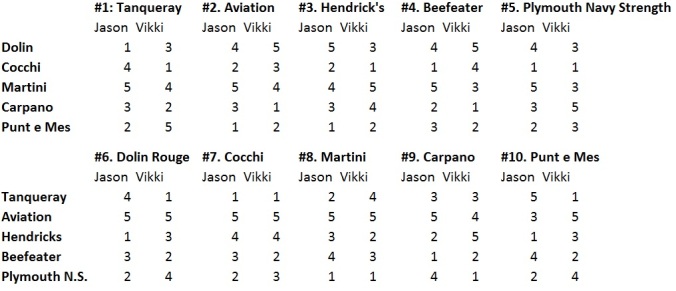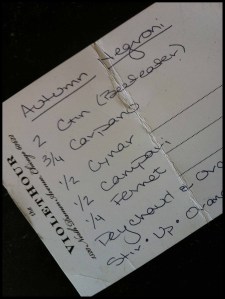We’re here to talk about sparkling water in cocktails. But first:
My Obsessive Nature, a.k.a. A Briefish, Seemingly Unrelated Disclaimer on Why Its Hard to Buy Things
I like research.
Before I buy something, for example, I tend to comb through reviews. This can be important, like finding the right hotel for a vacation. This can also be shatteringly unimportant, like when I suddenly realize I’ve wasted 90 minutes on a Tuesday morning comparing customer reviews and build specifications between a bunch of $12 can openers. I can’t help it. It’s who I am.
I say that to say this: what follows is an article about what carbonated water is best for your cocktails. My conclusions have changed my thinking about soda water (a little). But even at its most dramatic, we’re talking about a flavor difference of 20% maximum, and usually closer to 5%. Which is my way of acknowledging that what follows is esoteric and largely insignificant, and if you ignore my conclusions regarding sodium content vis-a-vie effervescent cocktails, I assure you that your life won’t be any worse for it.
Anyway.
Carbonated Water & Its Many Forms
Carbonated water is what happens when carbon dioxide and water are hanging out together under pressure. Sometimes it’s natural: mineral-laden water, bubbling up through limestone in underground springs, finds some trapped underground CO2 and self-carbonates. People used to find these special places, and drink/soak there as a medicine. When they’re constantly traveling to Bath to “take the waters” in Jane Austen novels? This is what they’re doing.
Some of the carbonated water you can buy is natural, and while others are imitations of the natural minerals, or the natural carbonation, or both. All in all, you can break down bubble water into 4 different categories.
Four Categories
• Carbonated Water or Seltzer Water or Sparkling Water: pure water, artificially carbonated.
• Soda Water or Club Soda: water, carbon dioxide, and small amounts of added sodium salt and/or potassium salt.
• Mineral Water: naturally carbonated water from a protected underground spring, containing more than 250 parts per million (ppm) dissolved minerals/salts, like sodium, magnesium, calcium, potassium, etc.
• Spring Water: water from a protected underground spring, containing less than 250ppm dissolved minerals/salts.
This alone is fairly simple, but it’s only the very beginning, because each individual brand of sparkling water needs to be evaluated on three traits. And these three traits aren’t in any way predictable from the four categories, because waters within the same category swing wildly from one extreme to the other.
Three Traits:
(1) How carbonated is it?
This is vital, and the only unconditional trait you need in your carbonated water. You want big, ripping carbonation. In something like a Tom Collins, carbonated water is only about 1/3 of the liquid in the final drink, and has to carry twice its own weight in effervescence. The more carbonation, the brighter and more alive your drink will be.
(2) How does it taste?
Carbonating water is like hitting it with a spotlight — bad tasting water tastes even worse carbonated.
![[soda] jarritos](https://drinksanddrinking.files.wordpress.com/2016/04/soda-jarritos1.jpg?w=190&h=235) (3) How does the mineral composition affect the experience of flavor?
(3) How does the mineral composition affect the experience of flavor?
As affirmed by Dave Arnold and explained well by Kevin Liu here, a very small amount of salt can make flavors “pop,” even if it’s not enough to actually perceive any salt at all (known as subthreshhold saltiness).
To compound that, we know a small amount of salt is incredibly effective at reducing bitterness, so in the case of bitter sparkling drinks like Americanos or Campari & Soda, it might give the the other flavors a boost.
The Experiments:
I picked up a couple bottles of every brand of sparkling water I could find. Which is, by the way, a good way to look insane in the check-out aisle.
I got a couple rain-cheap grocery store brands, a few world-famous mineral waters, two ludicrously expensive artisanal mixing waters straight from an advertisement in Imbibe, some super basic carbonated distilled water, and capped off by a gift: the elusive and broadly-revered Topo Chico, courtesy of the excellent Carlos Ochoa.
12 waters in all, and a decently representative sample:
San Pellegrino and Crystal Geyser were immediately disqualified for insufficient carbonation, and Crystal Geyser doubly because it sucks (In my notes is one line, a cryptic, but damning, “this is shit and the people who make it are shit and I hate them.”).
Then, we did tests. Lots of tests.
All in all, I blind tasted all of them, 6 at a time, shuffled randomly:
— 2 rounds all the way through, just water alone
— 6 rounds as Americanos
— 3 rounds as Lillet + Sodas
— 2 rounds as Tequila + Sodas
— 1 round as Gin + Sodas
— 1 round as Vodka + Sodas
— 1 round of Tom Collins’
So why did I do this so many times? Because the results were incredibly subtle, and maddeningly inconsistent. I’ve never experienced anything like this. One round of Americanos, Fever Tree is the best. A few more rounds it hovers around 2nd or 3rd place, and then once it drops to last. Mineragua was 3rd place for the first Lillet + Soda test, but then the next time it drops to last. La Croix is an underperformer at Americanos but it makes the 2nd best Lillet + Soda. My homemade soda + a crack of salt made the best tequila soda, but when bittersness came in, it was only 4th best at an Americano. Why is Refreshe Seltzer better than Refreshe Soda? WHY?
I mean really. What the fuck am I supposed to do with this?
Conclusions:
I did it so many times that, yes, I managed to find patterns and draw conclusions:
(1) The biggest factor is the amount of carbonation. If you taste the water, hold it in your mouth before you swallow. CO2 in liquids forms carbonic acid, and it should burn. If you can pleasantly hold it in your mouth for 5 seconds, it’s not carbonated enough. San Pellegrino is nice for lunch, but it’s nowhere near bubbly enough for your cocktails.
(2) We’re really only talking about simple Americanos or spirit/wine + bubbles. In the round of Tom Collins’, which introduces sweetness and tartness, I literally couldn’t tell the difference between the 3 or 4 best versions. Just bring enough carbonation, and it’s fine.
(3) The more bitter your cocktail, the saltier your water. Q Soda and Mineragua in particular are salty as hell, but in bitter drinks they make the flavors pop because of that salt + bitterness thing we mentioned earlier. And the top performers, as far as I could tell, just had sea salt. Sodium citrate, an industrial salt in the Refreshe Soda, was not as beneficial.
(4) Enjoying a water alone and its performance in cocktails are two very different things. Both Q and Mineragua, for example, are too salty for me alone, but added to bitter sweetness in an Americano, that ceases to be a problem. Likewise, Fever Tree is the king of sipping waters in my house, but it doesn’t come close to dominating the competition the way I thought it would.
(5) We’re not talking about a big flavor difference here. This ain’t different vermouths, or even different gins. We’re talking about water. For most of these we’re dealing with shades of carbonation and shades of salt. The subjective difference between 1st and 4th in the conclusions could very well have been due to what I ate last.
(6) Water costs money. More on this in a second.
What’s the Best Sparkling Water for Cocktails?:
Q Club Soda.
Big carbonation, nice and salty, and well flavored, Q was the best all around competitor, with Fever Tree, Refreshe Seltzer, Topo Chico, Mineragua, and my homemade water (carbonation technique nicked from Liquid Intelligence) coming in as respectable runner ups.
But.
If I didn’t have my own, would I be buying Q Club for home? No, I would not. I would be buying Refreshe Seltzer and adding a pinch of salt (or Topo Chico, if I could find it). Because of the final column, cost, that I left off earlier.
If I were in some kind of competition, I’d bring Q Club. But it’s not significant enough of a difference for me to buy boutique imported water at nearly $0.20 a fucking ounce. Q was best, and Refreshe Seltzer is somewhere around 3rd. But Q is 7.5x the cost of Refreshe, and only like 5% better. And I’m not living that life.
In other words, did I just make you read 1500 words on carbonated water just to tell you it doesn’t matter all that much? Yeah, I did. Sorry. I tried to warn you.
SUPPLIMENTAL CAVEAT: There’s still so much I don’t know about these waters. Sodium, in miligrams, is available on the back. But what about potassium? Or calcium, or magnesium, or fluoride, or nitrates? All that stuff can show up in mineral water, and it tastes like something, and I don’t have the tools to identify them. And honestly, what tools I could’ve bought (pH strips, etc) I opted against buying when I realized how difficult it is to draw conclusions from such scattered, subtle results in the first place.
TRIVIA #1!: Why is salted water even a thing at all? This is already much too long, but the history of artificial carbonation is pretty awesome, so I’ll just leave this superb article here if you want to know more.
TRIVIA #2!: If you’re wondering if the English town of Bath was named Bath because people bathed in the natural hot springs, the answer is yes.
![[soda] round 1](https://drinksanddrinking.files.wordpress.com/2016/04/soda-round-1.jpg?w=676&h=454)
![[soda] the lineup](https://drinksanddrinking.files.wordpress.com/2016/04/soda-the-lineup.jpg?w=676&h=639)
![[soda] cost difference supermarket](https://drinksanddrinking.files.wordpress.com/2016/04/soda-cost-difference-supermarket.jpg?w=676&h=341)
![[soda] grid](https://drinksanddrinking.files.wordpress.com/2016/04/soda-grid.jpg?w=676)
![[soda] tons of rounds](https://drinksanddrinking.files.wordpress.com/2016/04/soda-tons-of-rounds.jpg?w=676&h=213)

![[soda] q winner](https://drinksanddrinking.files.wordpress.com/2016/04/soda-q-winner.jpg?w=676&h=881)
![[soda] winners circle](https://drinksanddrinking.files.wordpress.com/2016/04/soda-winners-circle.jpg?w=676&h=454)
![[soda] grid w prices](https://drinksanddrinking.files.wordpress.com/2016/04/soda-grid-w-prices.jpg?w=676)
![I really enjoyed this process. [nt] stirring](https://drinksanddrinking.files.wordpress.com/2015/08/nt-stirring.jpg?w=676&h=456)
![I made this one specifically for the photoshoot, but take heart, no Negronis were wasted in the production of these photographs. [nt] intro glamour shot](https://drinksanddrinking.files.wordpress.com/2015/08/nt-intro-glamour-shot.jpg?w=676&h=456)
![Sloppy numbers written on a paper towel. because classy. [nt] double blind](https://drinksanddrinking.files.wordpress.com/2015/08/nt-double-blind.jpg?w=676&h=231)
![I did not do this in one night. [nt] intro montage](https://drinksanddrinking.files.wordpress.com/2015/08/nt-intro-montage.jpg?w=676&h=279)

![This picture is here because there are too many statistics and you lovely people deserve a picture. [nt] test lineup](https://drinksanddrinking.files.wordpress.com/2015/08/nt-test-lineup.jpg?w=676&h=241)
![Champion ingredients get champion lighting. [nt] winner!](https://drinksanddrinking.files.wordpress.com/2015/08/nt-winner.jpg?w=676&h=483)
![Fun fact: I bought that shitty little Beefeater flask because I accidently dropped the bottle, which shattered and embedded some glass in my foot. For science. [nt] gin lineup](https://drinksanddrinking.files.wordpress.com/2015/08/nt-gin-lineup.jpg?w=676&h=456)
![Anyone want some extra Martini and Rossi? [nt] vermouth lineup](https://drinksanddrinking.files.wordpress.com/2015/08/nt-vermouth-lineup.jpg?w=676&h=459)
![[campari] intro](https://drinksanddrinking.files.wordpress.com/2015/02/campari-intro.jpg?w=676&h=490)
![[campari] detail bottle](https://drinksanddrinking.files.wordpress.com/2015/02/campari-detail-bottle.jpg?w=676&h=456)
![[campari] drinking](https://drinksanddrinking.files.wordpress.com/2015/02/campari-drinking.jpg?w=676&h=1000)


